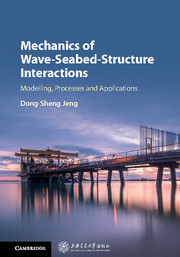Book contents
- Frontmatter
- Contents
- Preface
- 1 Overview
- 2 Basic Seabed Mechanisms
- 3 Soil Response in Marine Sediments under Combined Loading of Waves and Currents
- 4 Integrated Model of Wave-Seabed Interactions around Caisson-Type Breakwaters
- 5 Mechanics of Wave-Seabed-Pipeline Interactions
- 6 Three-Dimensional Model of Wave-Seabed Interactions around Breakwater Heads
- 7 Seabed Instability around Offshore Wind Turbine Foundations
- 8 Physical Modelling: One-Dimensional Compressive Tests
- Appendix A Analytical Solution for a Seabed of Finite Thickness (Hsu & Jeng 994)
- Appendix B Derivation of u–p Approximation (Jeng et al. 1999)
- Appendix C Derivation of u–U Approximation (Cha et al. 2002)
- Appendix D Mathematical Derivations of Analytical Solutions for Residual Soil Response (Jeng et al. 2007)
- Appendix E Mathematical Model of the Two-Layered Viscous Fluid System (Liu et al. 2009)
- References
- Author Index
- Subject Index
5 - Mechanics of Wave-Seabed-Pipeline Interactions
Published online by Cambridge University Press: 28 April 2018
- Frontmatter
- Contents
- Preface
- 1 Overview
- 2 Basic Seabed Mechanisms
- 3 Soil Response in Marine Sediments under Combined Loading of Waves and Currents
- 4 Integrated Model of Wave-Seabed Interactions around Caisson-Type Breakwaters
- 5 Mechanics of Wave-Seabed-Pipeline Interactions
- 6 Three-Dimensional Model of Wave-Seabed Interactions around Breakwater Heads
- 7 Seabed Instability around Offshore Wind Turbine Foundations
- 8 Physical Modelling: One-Dimensional Compressive Tests
- Appendix A Analytical Solution for a Seabed of Finite Thickness (Hsu & Jeng 994)
- Appendix B Derivation of u–p Approximation (Jeng et al. 1999)
- Appendix C Derivation of u–U Approximation (Cha et al. 2002)
- Appendix D Mathematical Derivations of Analytical Solutions for Residual Soil Response (Jeng et al. 2007)
- Appendix E Mathematical Model of the Two-Layered Viscous Fluid System (Liu et al. 2009)
- References
- Author Index
- Subject Index
Summary
Introduction
Submarine pipelines play an extremely important role in the transportation of offshore energy resources, which is one of the main concerns of offshore engineering. In general, the fluctuating pressures acting upon the seabed due to the progressive motion of ocean waves will further induce excess pore pressure and reduce the effective stress within the seabed soil. When the excess pore pressure increases, the vulnerability of underwaterlaid pipelines may be exposed due to wave-induced liquefaction of underlying seabed soil layers. Therefore, the evaluation of the wave-induced soil response is particularly important for offshore engineers involved in the protective design of offshore pipelines.
Because of the existence of embedded pipelines, the generation of pore pressure in adjacent zones is quite different from that in the far field. Some experimental and numerical studies have been carried out to investigate the characteristics of oscillatory pore pressure near the pipeline, as well as the effects of wave and seabed parameters. Among these, Turcotte, Liu & Kulhawy (1984) conducted a series of wave tests to investigate the wave-induced oscillatory pore pressure around a buried pipeline. In their experiments, the pore pressures along the pipeline were measured. Cheng & Liu (1986) proposed a boundary-integral method to investigate the dynamic response of a seabed with a buried pipeline. In both of these approaches, the pipeline was buried in a rectangular trench layer with impermeable walls. Later, Madga (1996) proposed a one-dimensional simplified finite element model to investigate the wave-induced uplift seepage around a pipeline, which was further applied to investigate the seabed instability (Madga 1997). Based on Biot's (1941) poro-elastic theory, a two-dimensional finitedifference model was established for wave-seabed-pipe interactions in an isotropic homogeneous seabed (Jeng & Cheng 1999), which was further used to investigate seabed instability caused by liquefaction and shear failure around a pipeline (Jeng & Cheng 2000).
Based on the principle of repeatability (Zienkiewicz & Scott 1972), a finite element model was established for a Gibson soil (Jeng & Lin 1999b), a general non-homogeneous seabed (Jeng & Lin 1999a) and a cross-anisotropic seabed with a cover layer (Wang et al. 2000). With the same framework, the model was further extended by considering the pipeline as an elastic material to examine the internal stresses of the pipeline for different conditions (Jeng 2001c; Jeng, Postma & Lin 2001).
- Type
- Chapter
- Information
- Mechanics of Wave-Seabed-Structure InteractionsModelling, Processes and Applications, pp. 177 - 234Publisher: Cambridge University PressPrint publication year: 2018



